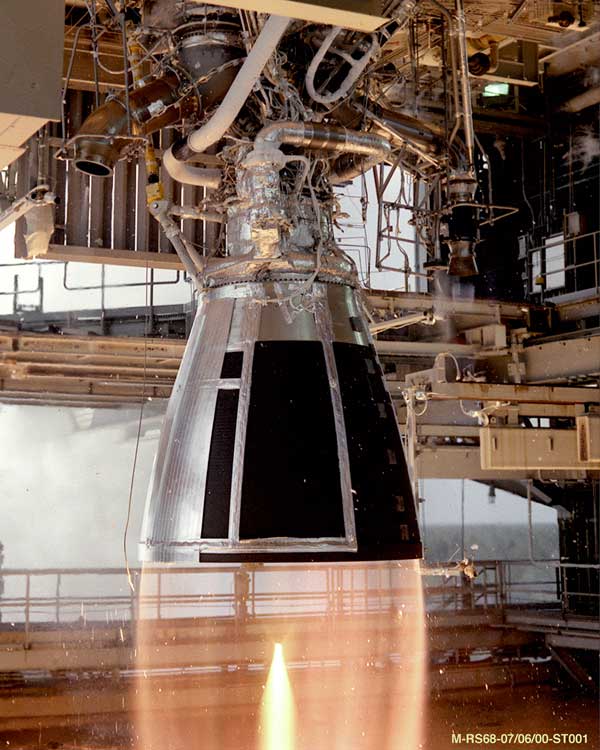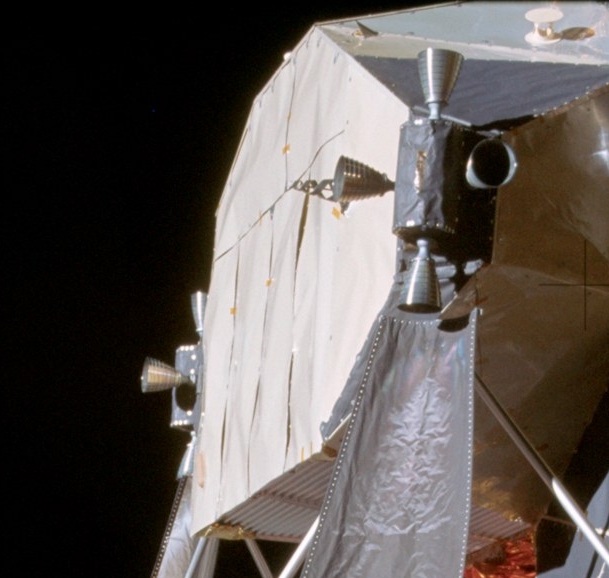|
öv
Delta-''v'' (also known as "change in velocity"), symbolized as and pronounced , as used in spacecraft flight dynamics, is a measure of the impulse per unit of spacecraft mass that is needed to perform a maneuver such as launching from or landing on a planet or moon, or an in-space orbital maneuver. It is a scalar that has the units of speed. As used in this context, it is not the same as the physical change in velocity of said spacecraft. A simple example might be the case of a conventional rocket-propelled spacecraft, which achieves thrust by burning fuel. Such a spacecraft's delta-''v'', then, would be the change in velocity that spacecraft can achieve by burning its entire fuel load. Delta-''v'' is produced by reaction engines, such as rocket engines, and is proportional to the thrust per unit mass and the burn time. It is used to determine the mass of propellant required for the given maneuver through the Tsiolkovsky rocket equation. For multiple maneuvers, delta-''v' ... [...More Info...] [...Related Items...] OR: [Wikipedia] [Google] [Baidu] |
Delta (letter)
Delta ( ; uppercase ö, lowercase öÇ; , ''dûˋlta'', ) is the fourth letter of the Greek alphabet. In the system of Greek numerals, it has a value of four. It was derived from the Phoenician alphabet, Phoenician letter Dalet (letter), dalet ÞÊ. Letters that come from delta include the Latin alphabet, Latin D and the Cyrillic script, Cyrillic De (Cyrillic), Å. A river delta (originally, the Nile Delta, delta of the Nile River) is named so because its shape approximates the triangular uppercase letter delta. Contrary to a popular legend, this use of the word ''delta'' was not coined by Herodotus. Pronunciation In Ancient Greek, delta represented a voiced dental plosive . In Modern Greek, it represents a voiced dental fricative , like the "''th''" in "''that''" or "''this''" (while in foreign words is instead commonly transcribed as ö§ü). Delta is romanization of Greek, romanized as ''d'' or ''dh''. Uppercase The uppercase letter ö is used to denote: * Change of any changeable ... [...More Info...] [...Related Items...] OR: [Wikipedia] [Google] [Baidu] |
Rocket Engine
A rocket engine is a reaction engine, producing thrust in accordance with Newton's third law by ejecting reaction mass rearward, usually a high-speed Jet (fluid), jet of high-temperature gas produced by the combustion of rocket propellants stored inside the rocket. However, non-combusting forms such as cold gas thrusters and nuclear thermal rockets also exist. Rocket vehicles carry their own oxidiser, unlike most combustion engines, so rocket engines can be used in a vacuum, and they can achieve great speed, beyond escape velocity. Vehicles commonly propelled by rocket engines include missiles, Rocket-assisted projectile, artillery shells, ballistic missiles and rockets of any size, from tiny Rocket (firework), fireworks to Rocket (weapon), man-sized weapons to huge Space vehicle, spaceships. Compared to other types of jet engine, rocket engines are the lightest and have the highest thrust, but are the least propellant-efficient (they have the lowest specific impulse). The ideal ... [...More Info...] [...Related Items...] OR: [Wikipedia] [Google] [Baidu] |
Staging (rocketry)
A multistage rocket or step rocket is a launch vehicle that uses two or more rocket ''stages'', each of which contains its own engines and propellant. A ''tandem'' or ''serial'' stage is mounted on top of another stage; a ''parallel'' stage is attached alongside another stage. The result is effectively two or more rockets stacked on top of or attached next to each other. Two-stage rockets are quite common, but rockets with as many as five separate stages have been successfully launched. By jettisoning stages when they run out of propellant, the mass of the remaining rocket is decreased. Each successive stage can also be optimized for its specific operating conditions, such as decreased atmospheric pressure at higher altitudes. This ''staging'' allows the thrust of the remaining stages to more easily accelerate the rocket to its final velocity and height. In serial or tandem staging schemes, the first stage is at the bottom and is usually the largest, the second stage and subse ... [...More Info...] [...Related Items...] OR: [Wikipedia] [Google] [Baidu] |
Spacecraft Propulsion
Spacecraft propulsion is any method used to accelerate spacecraft and artificial satellites. In-space propulsion exclusively deals with propulsion systems used in the vacuum of space and should not be confused with space launch or atmospheric entry. Several methods of pragmatic spacecraft propulsion have been developed, each having its own drawbacks and advantages. Most satellites have simple reliable chemical thrusters (often monopropellant rockets) or resistojet rockets for orbital station-keeping, while a few use Reaction wheel, momentum wheels for attitude control. Russian and antecedent Soviet bloc satellites have used Spacecraft electric propulsion, electric propulsion for decades, and newer Western geo-orbiting spacecraft are starting to use them for northãsouth station-keeping and orbit raising. Interplanetary vehicles mostly use chemical rockets as well, although a few have used electric propulsion such as ion thrusters and Hall-effect thrusters. Various technologies ... [...More Info...] [...Related Items...] OR: [Wikipedia] [Google] [Baidu] |
Exponential Growth
Exponential growth occurs when a quantity grows as an exponential function of time. The quantity grows at a rate directly proportional to its present size. For example, when it is 3 times as big as it is now, it will be growing 3 times as fast as it is now. In more technical language, its instantaneous rate of change (that is, the derivative) of a quantity with respect to an independent variable is proportional to the quantity itself. Often the independent variable is time. Described as a function, a quantity undergoing exponential growth is an exponential function of time, that is, the variable representing time is the exponent (in contrast to other types of growth, such as quadratic growth). Exponential growth is the inverse of logarithmic growth. Not all cases of growth at an always increasing rate are instances of exponential growth. For example the function f(x) = x^3 grows at an ever increasing rate, but is much slower than growing exponentially. For example, w ... [...More Info...] [...Related Items...] OR: [Wikipedia] [Google] [Baidu] |
Electrically Powered Spacecraft Propulsion
Spacecraft electric propulsion (or just electric propulsion) is a type of spacecraft propulsion technique that uses electrostatic or electromagnetic fields to accelerate mass to high speed and thus generating thrust to modify the velocity of a spacecraft in orbit. The propulsion system is controlled by power electronics. Electric thrusters typically use much less propellant than chemical rockets because they have a higher exhaust speed (operate at a higher specific impulse) than chemical rockets.Choueiri, Edgar Y. (2009New dawn of electric rocket''Scientific American'' 300, 58ã65 Due to limited electric power the thrust is much weaker compared to chemical rockets, but electric propulsion can provide thrust for a longer time. Electric propulsion was first demonstrated in the 1960s and is now a mature and widely used technology on spacecraft. American and Russian satellites have used electric propulsion for decades. , over 500 spacecraft operated throughout the Solar System ... [...More Info...] [...Related Items...] OR: [Wikipedia] [Google] [Baidu] |
Impulsive Maneuver
In spaceflight, an orbital maneuver (otherwise known as a burn) is the use of propulsion systems to change the orbit of a spacecraft. For spacecraft far from Earth, an orbital maneuver is called a ''deep-space maneuver (DSM)''. When a spacecraft is not conducting a maneuver, especially in a transfer orbit, it is said to be ''coasting''. General Rocket equation The Tsiolkovsky rocket equation, or ideal rocket equation, can be useful for analysis of maneuvers by vehicles using rocket propulsion. A rocket applies acceleration to itself (a thrust) by expelling part of its mass at high speed. The rocket itself moves due to the conservation of momentum. Delta-v The applied change in velocity of each maneuver is referred to as delta-v (\Delta\mathbf\,). The delta-v for all the expected maneuvers are estimated for a mission are summarized in a delta-v budget. With a good approximation of the delta-v budget designers can estimate the propellant required for planned maneuvers ... [...More Info...] [...Related Items...] OR: [Wikipedia] [Google] [Baidu] |
Kepler Orbit
In celestial mechanics, a Kepler orbit (or Keplerian orbit, named after the German astronomer Johannes Kepler) is the motion of one body relative to another, as an ellipse, parabola, or hyperbola, which forms a two-dimensional orbital plane in three-dimensional space. A Kepler orbit can also form a straight line. It considers only the point-like gravitational attraction of two bodies, neglecting perturbations due to gravitational interactions with other objects, atmospheric drag, solar radiation pressure, a non- spherical central body, and so on. It is thus said to be a solution of a special case of the two-body problem, known as the Kepler problem. As a theory in classical mechanics, it also does not take into account the effects of general relativity. Keplerian orbits can be parametrized into six orbital elements in various ways. In most applications, there is a large central body, the center of mass of which is assumed to be the center of mass of the entire system. B ... [...More Info...] [...Related Items...] OR: [Wikipedia] [Google] [Baidu] |
Reaction Control System
A reaction control system (RCS) is a spacecraft system that uses Thrusters (spacecraft), thrusters to provide Spacecraft attitude control, attitude control and translation (physics), translation. Alternatively, reaction wheels can be used for attitude control, rather than RCS. Use of diverted engine thrust to provide stable attitude control of a V/STOL, short-or-vertical takeoff and landing aircraft below conventional winged flight speeds, such as with the Hawker Siddeley Harrier#Controls and handling, Harrier "jump jet", may also be referred to as a reaction control system. Reaction control systems are capable of providing small amounts of thrust in any desired direction or combination of directions. An RCS is also capable of providing torque to allow control of rotation (aircraft principal axes, roll, pitch, and yaw). Reaction control systems often use combinations of large and small (vernier thruster, vernier) thrusters, to allow different levels of response. Uses Spacecr ... [...More Info...] [...Related Items...] OR: [Wikipedia] [Google] [Baidu] |
Hydrazine
Hydrazine is an inorganic compound with the chemical formula . It is a simple pnictogen hydride, and is a colourless flammable liquid with an ammonia-like odour. Hydrazine is highly hazardous unless handled in solution as, for example, hydrazine hydrate (). Hydrazine is mainly used as a foaming agent in preparing Polymeric foam, polymer foams, but applications also include its uses as a precursor (chemistry), precursor to pharmaceuticals and agrochemicals, as well as a long-term storable propellant for in-outer space, space spacecraft propulsion. Additionally, hydrazine is used in various rocket propellant, rocket fuels and to prepare the gas precursors used in airbags. Hydrazine is used within both nuclear and conventional electrical power plant steam cycles as an oxygen scavenger to control concentrations of dissolved oxygen in an effort to reduce corrosion. , approximately 120,000 tons of hydrazine hydrate (corresponding to a 64% solution of hydrazine in water by weight) we ... [...More Info...] [...Related Items...] OR: [Wikipedia] [Google] [Baidu] |
Nozzle
A nozzle is a device designed to control the direction or characteristics of a fluid flow (specially to increase velocity) as it exits (or enters) an enclosed chamber or pipe (material), pipe. A nozzle is often a pipe or tube of varying cross sectional area, and it can be used to direct or modify the flow of a fluid (liquid or gas). Nozzles are frequently used to control the rate of flow, speed, direction, mass, shape, and/or the pressure of the stream that emerges from them. In a nozzle, the velocity of fluid increases at the expense of its pressure energy. Types Jet A gas jet, fluid jet, or hydro jet is a nozzle intended to eject gas or fluid in a coherent stream into a surrounding medium. Gas jets are commonly found in gas stoves, ovens, or barbecues. Gas jets were commonly used for Gas lighting, light before the development of electric light. Other types of fluid jets are found in carburetors, where smooth calibrated orifices are used to regulate the flow of gasoline, fuel ... [...More Info...] [...Related Items...] OR: [Wikipedia] [Google] [Baidu] |
Delta-v Budget
Delta-''v'' (also known as " change in velocity"), symbolized as and pronounced , as used in spacecraft flight dynamics, is a measure of the impulse per unit of spacecraft mass that is needed to perform a maneuver such as launching from or landing on a planet or moon, or an in-space orbital maneuver. It is a scalar that has the units of speed. As used in this context, it is not the same as the physical change in velocity of said spacecraft. A simple example might be the case of a conventional rocket-propelled spacecraft, which achieves thrust by burning fuel. Such a spacecraft's delta-''v'', then, would be the change in velocity that spacecraft can achieve by burning its entire fuel load. Delta-''v'' is produced by reaction engines, such as rocket engines, and is proportional to the thrust per unit mass and the burn time. It is used to determine the mass of propellant required for the given maneuver through the Tsiolkovsky rocket equation. For multiple maneuvers, delt ... [...More Info...] [...Related Items...] OR: [Wikipedia] [Google] [Baidu] |







